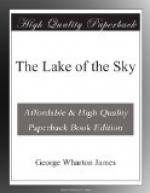[Footnote 3: It is proper to add that Fluctuations of level in the North American lakes have been noticed by various observers, from the time of the Jesuit Fathers of the period of Marquette, in 1673, down to the present epoch. Among those who have discussed this problem may be mentioned in chronological order: Fra Marquette in 1673, Baron La Hontan 1689, Charlevoix 1721, Carver 1766, Weld 1796, Major S.A. Storrow 1817, Capt. Henry Whiting 1819, H.R. Schoolcraft 1820, Gen. Dearborn 1826-29.]
CHAPTER VII
HOW LAKE TAHOE WAS FORMED
Lindgren, the geologist, affirms that after the Sierra Nevada range was thrust up, high into the heavens, vast and long continued erosion “planed down this range to a surface of comparatively gentle topography.” He claims that it must originally have been of great height. Traces of this eroded range (Cretaceous) “still remain in a number of flat-topped hills and ridges that rise above the later tertiary surface. There is reason to believe that this planed-down mountain range had a symmetrical structure, for somewhat to the east of the present divide is a well-marked old crest line extending from the Grizzly Peak Mountains on the north, in Plumas County, at least as far south as Pyramid Peak, in Eldorado County. At sometime in the later part of the Cretaceous period the first breaks took place, changing the structure of the range from symmetrical to monoclinal and outlining the present form of the Sierra Nevada.”
This great disturbance he thinks, “was of a two-fold character, consisting of the lifting up of a large area including at least a part of the present Great Basin [Nevada and Utah] and a simultaneous breaking and settling of the higher portions of the arch. Along the eastern margin a system of fractures was thus outlined which toward the close of the Tertiary was to be still further emphasized. The main break probably extended from a point south of Mono Lake to Antelope Valley and from Markleeville northward toward Sierra Valley. A large part of the crust block to the west of this dislocation also sank down. This sunken area is now indicated by Lake Tahoe and by its northward continuation, Sierra Valley, separated from each other only by masses of Tertiary lavas.... It is worthy of note that within the area of the range no volcanic eruptions accompanied this subsidence.”
He continues: “As a consequence of this uplift the erosive power of the streams was rejuvenated, the Cretaceous surface of gentle outline was dissected, and the rivers began to cut back behind the old divide, carrying their heads nearly to the present crest line that separates the slope of the Sierra from the depression of Lake Tahoe.”
These rivers are the great gold bearing streams that caused the mining excitement of 1849. They all head near the Tahoe region, and include the Yuba, Feather, American, Mokelumne, Calaveras, Cataract, and Tuolumne.




